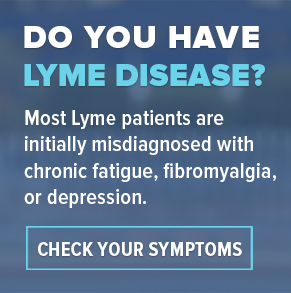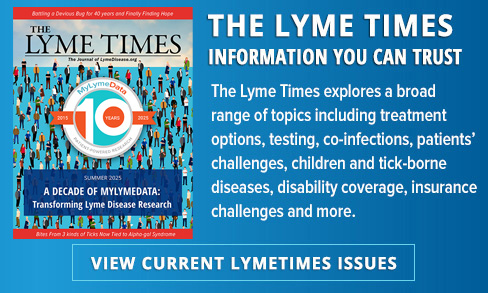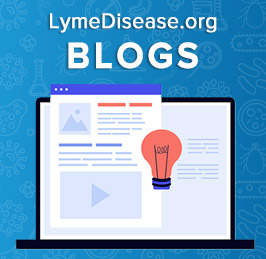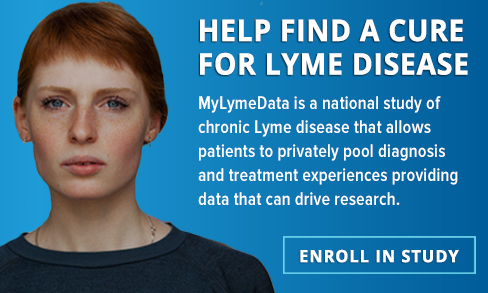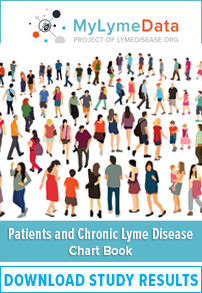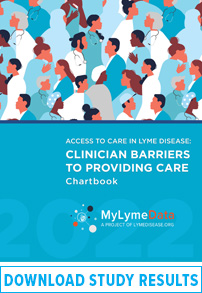PATIENT-LED RESEARCH FOR LYME DISEASE
Focused on People Who Matter the Most — Patients
For more than ten years, LymeDisease.org has been conducting patient-led research using patient-generated data. Lyme patients are experts in their illness. Patient-powered research takes the traditional top down expertise driven academic research model and turns it on its head. It is conceived by patients, is run by patients, and addresses issues that matter to patients.
Our patient registry, MyLymeData, is contributing to the knowledge base of Lyme disease by collecting, compiling, and analyzing the data essential to understanding and effectively treating chronic Lyme disease. We have published 7 peer-reviewed big-data studies to date and are in the process of publishing others.

Does Biological Sex Matter in Lyme Disease? The Need for Sex-Disaggregated Data in Persistent Illness
An implicit and inaccurate assumption underlying most medical research is that aside from reproductive matters, men and women do not differ substantially in their physiological and pathological response to disease. Most research was primarily conducted on men until 2015 when the National Institutes of Health (NIH) began requiring that sex be included as a biological variable factored into research designs and reported in both animal and human studies. Consideration of sex is now seen as critical to the interpretation, validation, and generalizability of research findings. However, in the case of Lyme disease, only a handful of papers have meaningfully analyzed differences linked to sex.

Access to Care in Lyme Disease: Clinician Barriers to Providing Care
Patients with persistent Lyme disease/chronic Lyme disease (PLD/CLD) encounter significant barriers to accessing medical care. Although this health inequity has been explored from the patient perspective, the obstacles clinicians encounter when providing care to this group of patients have not been examined. The primary goal of this study was to identify the challenges faced by clinicians who provide care for patients with PLD/CLD. Clinicians who treat PLD/CLD were surveyed regarding their professional backgrounds, general challenges to providing care, supply and demand constraints, insurance restrictions, and regulatory and legal challenges. Clinicians treating patients with PLD/CLD have developed substantial clinical expertise but encounter multiple clinical, regulatory and financial impediments to providing care. Clinician-encountered barriers may be powerful disincentives for providing care patients with PLD/CLD and make it difficult to retain and recruit clinicians who will care for the rapidly expanding PLD/CLD populations. Understanding these barriers and identifying potential solutions is essential to resolving the current supply/demand imbalance that makes it difficult for patients to receive the care they need to become well.

Feature Selection from Lyme Disease Patient Survey Using Machine Learning
Lyme disease is a rapidly growing illness that remains poorly understood within the medical community. Critical questions about when and why patients respond to treatment or stay ill, what kinds of treatments are effective, and even how to properly diagnose the disease remain largely unanswered. We investigate these questions by applying machine learning techniques to a large scale Lyme disease patient registry, MyLymeData, developed by the nonprofit LymeDisease.org. We apply various machine learning methods in order to measure the effect of individual features in predicting participants’ answers to the Global Rating of Change (GROC) survey questions that assess the self-reported degree to which their condition improved, worsened, or remained unchanged following antibiotic treatment. We use basic linear regression, support vector machines, neural networks, entropy-based decision tree models, and k-nearest neighbors approaches. We first analyze the general performance of the model and then identify the most important features for predicting participant answers to GROC. After we identify the “key” features, we separate them from the dataset and demonstrate the effectiveness of these features at identifying GROC. In doing so, we highlight possible directions for future study both mathematically and clinically.

Antibiotic Treatment Response in Chronic Lyme Disease: Why Do Some Patients Improve While Others Do Not?
There is considerable uncertainty regarding treatment of Lyme disease patients who do not respond fully to initial short-term antibiotic therapy. Choosing the best treatment approach and duration remains challenging because treatment response among these patients varies: some patients improve with treatment while others do not. A previous study examined treatment response variation in a sample of over 3500 patients enrolled in the MyLymeData patient registry developed by LymeDisease.org (San Ramon, CA, USA). That study used a validated Global Rating of Change (GROC) scale to identify three treatment response subgroups among Lyme disease patients who remained ill: nonresponders, low responders, and high responders. The present study first characterizes the health status, symptom severity, and percentage of treatment response across these three patient subgroups together with a fourth subgroup, patients who identify as well. We then employed machine learning techniques across these subgroups to determine features most closely associated with improved patient outcomes, and we used traditional statistical techniques to examine how these features relate to treatment response of the four groups. High treatment response was most closely associated with (1) the use of antibiotics or a combination of antibiotics and alternative treatments, (2) longer duration of treatment, and (3) oversight by a clinician whose practice focused on the treatment of tick-borne diseases.

Removing the Mask of Average Treatment Effects in Chronic Lyme Disease Research Using Big Data and Subgroup Analysis.
Lyme disease is caused by the bacteria borrelia burgdorferi and is spread primarily through the bite of a tick. There is considerable uncertainty in the medical community regarding the best approach to treating patients with Lyme disease who do not respond fully to short-term antibiotic therapy. These patients have persistent Lyme disease symptoms resulting from lack of treatment, under-treatment, or lack of response to their antibiotic treatment protocol. In the past, treatment trials have used small restrictive samples and relied on average treatment effects as their measure of success and produced conflicting results. To provide individualized care, clinicians need information that reflects their patient population. Today, we have the ability to analyze large data bases, including patient registries, that reflect the broader range of patients more typically seen in clinical practice. This allows us to examine treatment variation within the sample and identify groups of patients that are most responsive to treatment. Using patient-reported outcome data from the MyLymeData online patient registry, we show that sub-group analysis techniques can unmask valuable information that is hidden if averages alone are used. In our analysis, this approach revealed treatment effectiveness for up to a third of patients with Lyme disease. This study is important because it can help open the door to more individualized patient care using patient-centered outcomes and real-world evidence.

Severity of chronic Lyme disease compared to other chronic conditions: a quality of life survey.
Lyme disease is a rapidly growing illness that remains poorly understood within the medical community. Critical questions about when and why patients respond to treatment or stay ill, what kinds of treatments are effective, and even how to properly diagnose the disease remain largely unanswered. We investigate these questions by applying machine learning techniques to a large scale Lyme disease patient registry, MyLymeData, developed by the nonprofit LymeDisease.org. We apply various machine learning methods in order to measure the effect of individual features in predicting participants’ answers to the Global Rating of Change (GROC) survey questions that assess the self-reported degree to which their condition improved, worsened, or remained unchanged following antibiotic treatment. We use basic linear regression, support vector machines, neural networks, entropy-based decision tree models, and k-nearest neighbors approaches. We first analyze the general performance of the model and then identify the most important features for predicting participant answers to GROC. After we identify the “key” features, we separate them from the dataset and demonstrate the effectiveness of these features at identifying GROC. In doing so, we highlight possible directions for future study both mathematically and clinically.

Healthcare access and burden of care for patients with Lyme disease: a large United States survey.
Objective
To evaluate the challenges faced by Lyme disease patients in obtaining adequate healthcare.
Methods
A web-based survey conducted over nine months was analyzed for the study. The survey focused on medical status, access to healthcare, and burden of illness. For inclusion in the study, survey respondents had to reside in the United States, be more than 10 years old, and have clinically diagnosed Lyme disease with chronic symptoms and positive laboratory testing.
Results
Responses from 2424 patients were included in the study. Half of the respondents reported seeing at least seven physicians before the diagnosis of Lyme disease was made. Nearly half had Lyme disease for more than 10 years and traveled over 50 miles to obtain treatment. Most respondents experienced symptoms lasting six months or more despite receiving at least 21 days of antibiotic treatment. A quarter of respondents had been on public support or received disability benefits due to Lyme disease symptoms, and over half had visited an emergency room at least once as a result of these symptoms.
Conclusions
Lyme disease patients frequently endure extensive delays in obtaining an initial diagnosis, have poor access to healthcare and suffer a severe burden of illness.


